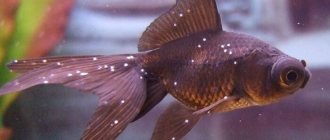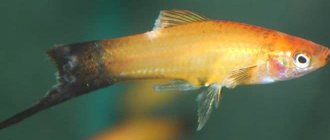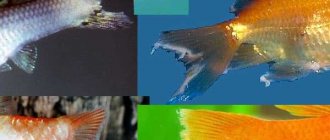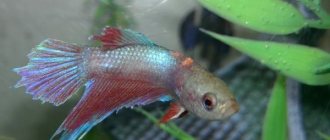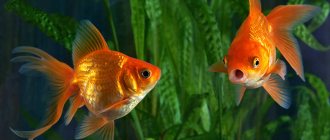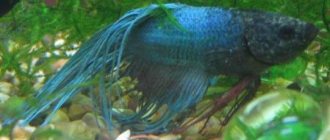4.9
(111)
When a person wants to start an aquarium, he, first of all, wants an underwater mini-world to appear at home, so that the fish will delight with their natural beauty. But, alas, modern decorative inhabitants are quite susceptible to all sorts of diseases. For example, every beginner or experienced aquarist is faced with such an unpleasant phenomenon as fin rot.
The initial stage of the disease with fin rot.
What is fin rot?
This is a fairly common disease that is bacterial in nature. It occurs due to infection by several types of bacteria, namely Pseudomonas, Aeromonas and Vibrio. The natural habitat of this infection is various bodies of water. In aquarium conditions, these bacteria do not grow on their own. Fish can only get sick if the owner purchased a new fish from a pet store but did not take the necessary precautions (week-long quarantine). In addition, fin rot can enter the aquarium with other carriers, namely: decor, soil (from a pond), natural plants and frozen food.
More susceptible to infection than others are such varieties of underwater fauna as guppies, angelfish, neons (of any color), goldfish (orandas, telescopes, veiltails), as well as all types of viviparous (swordtails, mollies) or labyrinthine (cockerels, gourami) fish.
It is worth noting that, first of all, fin rot in a general aquarium affects young animals; the chances that they will recover are small. Adults have stronger immunity, so a complete and rapid recovery is possible.
It can also be a secondary infection, which is accompanied by completely different symptoms, such as bloating or ulcers.
Fin rot can often be confused with alkaline disease, so it is important to pay close attention to all symptoms.
Despite the complexity of the disease, recovered fish are able to start the regeneration process and regrow fins. The better the conditions for keeping the fish, the more complete its nutrition, the sooner the damaged tissue will grow back. In addition, early identification of the problem and timely response will allow you to safely eliminate the disease and save your pet.
Identifying a specific diagnosis poses some difficulties, since fin rot is similar in its symptoms to alkaline disease. As the alkali concentration increases, some areas of the animal’s body (ventral, caudal, anal and dorsal fins) are also damaged. Therefore, to begin recovery, you need to know all the symptoms of this disease.
Symptoms of the disease
If you notice one of the following signs in your pets, you urgently need to start treatment:
- The fins, closer to the edge, lose color, become lighter, and become cloudy. This is the initial symptom of fin rot. Over time, the border grows and affects the entire fin. It is impossible not to notice the cloudiness of the fins of young animals, since they are mostly still transparent;
- Erosion grows intensively over the entire surface of the fins, provoking their disintegration;
- In young animals, the caudal and pectoral fins are primarily affected. In adults, damage occurs chaotically. In any case, rot begins at the edges and gradually reaches the base;
- Before the fin begins to disintegrate and rot, red spots and streaks may be visible on its surface. The reason for this is blockage of blood vessels;
- The eyes of some fish are also affected by this disease. The surface of the cornea becomes cloudy and acquires a whitish tint;
- Another symptom of fin rot is inflamed fin edges. They split and shorten in length over time. In fry, the fins simply dissolve;
- The damaged edges of the fins are white because ulcers with purulent fluid appear at the ends. Over time, the sores move to the beginning of the tail, and from there to the body. If the pet is not given timely help, the infection affects the entire body, and it dies.
Fin rot can be a secondary infection that is accompanied by completely different symptoms.
Description
The common goldfish is a species with a flat and elongated body. The head is wide and short; the body smoothly passes from the back and abdomen to the base of the caudal fin. The caudal fin is forked. As a rule, all fins are fully straightened, and the edge of the dorsal fin is slightly concave. The color is bright orange - this is a truly “golden” aquarium fish.
In a home aquarium, this species can reach 18-20 cm in length, and in a spacious pond up to 30 cm, and even up to 45 cm.
Very often, “goldfish” refers to all varieties of goldfish - veiltails, lionheads, orandas and even koi carps. However, they are all very different in appearance, and only with the “comet” goldfish is the “ordinary goldfish” really very similar. They have an identical body shape, but the comet's fins are much longer, especially the tail fin. In addition, the comet is reddish-orange (also found in yellow, orange, white and red), while the regular gold is more orange. "Comet" may be smaller in size, but it all depends on the conditions of detention. In both of these species the tail is held completely straight.
Another almost identical variety is the London shubunkin. Both fish have almost identical body and fin shapes, but the Shubunkin is a completely different color. While the regular goldfish has a bright orange metallic color, the London Shubunkin has a speckled, mottled color pattern.
The common goldfish is one of the hardiest goldfish species. It is not demanding on water quality and temperature and is suitable for both keeping in a home aquarium and in a decorative home pond.
The main conditions for successfully keeping this species are a spacious aquarium (pond) and its shape, with a large water surface area. One fish requires 57 liters of water to start with, and 90 liters ideally for an adult fish.
Since goldfish litter a lot, it is advisable to purchase a good, powerful filter to remove waste from the water.
These are cold-water fish; they do not need additional heating. The soil at the bottom should be, preferably shallow, so that uneaten food remains on the surface. Lighting, like decorations, can be anything.
Content Options
Temperature: 18 – 22 °C, but can tolerate very low temperatures, just above 0 °C; Breeding temperature: 20°C; ph: 6.0-8.0; General hardness: 5 - 19 dGH.
Water changes in the aquarium should be regular, 1/4 - 1/3 of the water volume weekly.
Treatment of fin rot in a community aquarium
If the disease is detected at an early stage, getting rid of it is quite simple. The first step is to set your aquarium heater to a higher setting (most bacteria do not grow in warm water). Regular replacements (about 30% of the total volume) will also be effective.
For several days, you should adhere to these conditions and monitor the affected pets. If no improvement occurs and fin rot continues to progress, then more drastic methods must be taken.
Drugs for treatment
Levomycetin . A common medicine that is found in almost every apartment. Has a fairly wide range of actions. It is not toxic, but a certain dosage is recommended. As a rule, to treat fin rot, you need to dilute half the tablet in one bucket of water (or 10 liters). The medicine must first be prepared for use. To do this, you need to crush the tablet in a teaspoon with the base of a knife, and dissolve the resulting mass in a small glass and add it to the container. The drug does not dissolve well, so you will need to mix the solution thoroughly. Replacements should be carried out about twice a week while maintaining the concentration of chloramphenicol. The duration of treatment is unlimited, as it is determined by the elimination of symptoms;
Streptocide . With this medicine the principle of use is the same as with the previous one. The only difference is that its dosage is different. To treat an animal, a concentration of 1.5 g/10 l is required. The fight against the disease is possible in the septic tank. But in this case, the concentration of the drug will be higher – 1 t/6 l, and the duration of the procedures will be shorter (no more than half an hour per day);
Bicillin-5 . It is sold in bottles and is added to water at the rate of 1/10 of a bottle per 10 liters. The solution is prepared in a separate container, where the sick fish are then placed for half an hour. Treatment is carried out daily for 6 days. During this period, the entire bottle of medicine must be used;
Biseptol-480 . 1/8 tablet dissolves in 5 liters of water. Every day you should prepare a new solution and transplant the fish into the fish tank with it. The treatment lasts a week, and all this time the sick fish must be in the solution. It is important to provide them with good aeration at this time;
To achieve maximum results during treatment, regular water changes (about 30%) are necessary.
Treatment of fin rot with salt . 3 tsp are diluted in a five-liter container. salt. Then the sick fish are placed in this solution. It is important to remember that not all fish can withstand extremely salty water. For example, for catfish, 2 grams per liter is enough, and 1 tsp. holds 7 grams. While infected pets are being treated for fin rot with salt in a fish tank, it is necessary to thoroughly treat the aquarium, equipment and soil with a 3% solution of chloramine, and wash the plants in a solution of bicillin-5. ;
Polymyxin . In a separate jar, 60 g of polymyxin is diluted per liter of water. Then the sick fish is placed there for half an hour every day. Duration of treatment – 5 days;
Methylene blue . A solution of 10 mg per liter is also prepared, and the fish are placed in it for half an hour. Treatment is carried out once every 2-3 days for two weeks;
Tetracycline . Depending on the severity of the disease, the concentration of the drug ranges from 3 to 6 g per liter of water. Every 24 hours you need to add a new portion of the medicine, changing a quarter of the water before that. Tetracycline does not work in water whose pH is 7.5 or more;
Hydrogen peroxide . The pharmaceutical solution is added to the water daily at the rate of 2.5 ml for every 10 liters of water. The duration of treatment for fin rot is 7-10 days, in advanced cases it can be extended to two weeks;
With a balanced diet and proper care, fish can regrow damaged fins.
Malachite green . In a separate container with a volume of 10 liters, prepare a solution in the ratio of 5 ml of malachite green and 5 drops of copper sulfate for every 10 liters of water in the aquarium. Then the solution is thoroughly mixed and added in three doses every 30 minutes to the aquarium. The procedure is carried out once a week, and the entire treatment period will take about a month. With a partial water change, it is necessary to restore the concentration of the drug;
Specialized products (Anti-steam, Tetra) . The drugs are powerful and effective. Add to the aquarium in a ratio of 1 ml for every 50 liters of water, having previously prepared the solution in a separate container. Before adding the drug to the aquarium, you need to change a third of the water to fresh water. Treatment is carried out for 5-7 days. The fish should not be fed during this time. It is also recommended to place the aquarium away from light and sunlight. Be sure to turn off aeration and filtration. In case of severe infection, it is necessary to prepare a concentrated bath - 1 ml of the drug per 10 liters of water, and keep the sick fish in it for three hours. For prevention, it is necessary to repeat the procedure a couple more times, with a break of a day.
How to speed up the growth of fins in fish?
The rate of regrowth may vary among different fish species. For example, goldfish, with good feeding and optimal maintenance, restore their fins in a month to a month and a half. Danio rerio, depending on the damage, grow “swimming accessories” in a week or two. Also, the speed of fin restoration depends on the age and structure of the radial tissue. Young cockerels, whose fins have few radial bifurcations, grow “oars” much faster.
Much of the success of regrowth depends on the cause of the damage. Provided that the fins are bitten in a fight, and the rays are not destroyed to the ground, the fish quickly and almost completely regenerates them. On the other hand, aquarium residents often lose their fins as a result of disease. In this case, the result of restoration is unpredictable. Overgrown organs can change their appearance and grow crookedly. Also, “revived” fins often have less intense coloring. So, how to speed up the regrowth of propellers in aquarium fish?
- Make sure the water is of good quality. To do this, you need to find out what water is recommended for the species contained in your “jar” and test the available water. Try using droplet tests from .
- It is advisable to add vitamins to the food. For example, “Fishtamin” is suitable for fin growing purposes.
- The food should be varied. If you use only dry food, the process will be delayed.
- Follow the water change schedule. Find out what substitutions are recommended for your species of fish. For example, in an overcrowded aquarium, to help the goldfish grow fins, changes must be made daily.
- Overpopulation of the aquarium should not be allowed - this provokes its inhabitants into aggression towards each other.
- Find out who is to blame for the loss of fins. If there are aggressive fish (shrimp or crayfish), move the “victims” away from them. Otherwise, nothing good will come of it.
Treatment of fin rot in cockerels
If a betta becomes ill, you should not immediately resort to using medications, but rather disinfect the aquarium.
The disease is treated quite effectively. There are a huge number of drugs that give a guaranteed result, and the fish recovers quickly. The main thing is to recognize the onset of the disease in a timely manner.
If fin rot occurs in a cockerel, you should not immediately resort to the use of medications. It is necessary to disinfect the soil, plants and accessories, replace a third of the water and raise the temperature to the maximum that the inhabitants can withstand. The aquarium is kept in such conditions for several days. If the disease does not recede, then the situation is somewhat more complicated. The use of special equipment will provide effective and quick results. They can be used in a community aquarium without removing infected pets. The aquarist adds the drug according to the instructions for five days. As a rule, this time is enough for the fin rot of the betta to be eliminated. In particularly difficult cases, treatment lasts up to ten days.
Treatment of fin rot in platies video:
Fin rot in guppies, treatment with Antipar video:
Mechanical damage
One of the reasons that guppies' tails break is mechanical damage. There are usually 2 reasons for this.
- The tail breaks on decorative objects or sharp stones at the bottom. Accordingly, to prevent recurrence of injuries, you should secure your aquarium. Remove all questionable decorative items; in some cases, you should pay attention to hard-leaved aquarium plants.
- Wrong neighborhood. Many aquarium inhabitants will be happy to play with them, or even hunt . First of all, crayfish, frogs, newts, etc. should come under suspicion. Well, next in line, for example, Sumatran barbs who decided to play with the tails of their neighbors. Check your aquarium pets for compatibility and if there is a discrepancy, seat them. Otherwise, you risk not only the appearance of the guppies, but also their lives.

